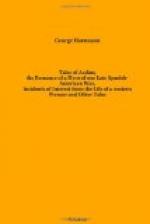They were placed in a row, facing the sun, about ten feet apart. A Zuni executioner, armed with a war club, was stationed in front of each victim, and another one, armed likewise, stood behind him. A war chief raised his arms and yelled, and forty clubs were raised in air. Then the great war drum, or tombe, boomed out the knell of death. There was a sickening, crashing thud, and twenty Navajos fell to earth with crushed skulls, each cabeza having been whacked simultaneously, right and left, fore and aft, by two stone clubs in the hands of a pair of devils.
It had always been an enigma to me that the Pueblo Indians, who were not to be matched as fighters against the Apache and Navajo had been able to defend their villages against the onslaught of these fierce tribes, their hereditary enemies. Don Juan Mestal enlightened me on that topic. He said the explanation therefor was to be found in a certain religious superstition of the Navajos and Apaches, which circumstance the Pueblo Indians took advantage of and exploited to the saving of their lives. When they had reason to expect an attack on their villages, the Pueblo laid numerous mines and torpedoes on all the approaches and streets of their towns. While these mines did not possess the destructive power of dynamite or gunpowder, they were equally effective and powerful, and never failed to repulse the enemy, especially if reinforced by hand grenades of like ammunition, thrown by squaws and pappooses from the flat roofs of their houses. By some means or other it had become known to the descendants of Montezuma that when an Apache stepped on something out of the ordinary “he scented mischief” and believed himself unclean and befouled with dishonor, and fancied himself disgraced before God and man; and forthwith he would hie himself away to do penance at the shrine of the nearest water sprite. This superstition they brought from Asia, their native land.




